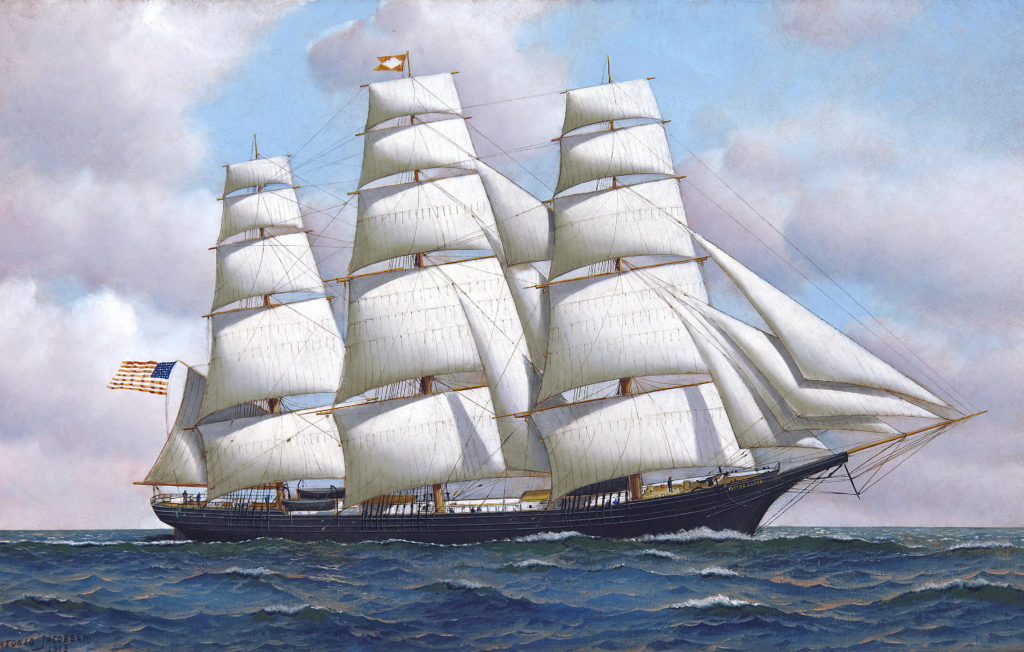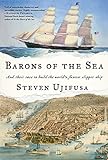On April 20, 1854, the clipper ship Flying Cloud sailed into San Francisco’s Golden Gate, setting a record of eighty-nine days and eight hours out from New York City. This would stand for 145 years, broken only in 1989 by a contemporary offshore racing yacht. That this record stood for so long, and that it was held by a commercial vessel no less, stands as a testament to the greatness of these pelagic thoroughbreds and the mariners who sailed them.
The clipper era was brief. As the historian Samuel Eliot Morison remarked, clipper ships were “our Gothic Cathedrals, our Parthenon; but . . . carved from snow.” These swift, lithe steeds raced not only each other, but also the inevitable steamship and railroad, and were soon wounded by the American Civil War and thence dispatched by the transcontinental railroad, a great golden spike through these hulls of oak. Thanks to naval historians like Morison, the clippers continue to occupy an outsized place in our national mythology, their metaphorical names familiar to many today: Flying Cloud, Sovereign of the Seas, Great Republic (pace the N. B. Palmer, a swift ship saddled with a decidedly terrestrial name). The clippers were among the first industrial triumphs of the young republic, built initially to best the merchant ships of the British Empire at its apex. Now Steven Ujifusa, in his well-researched Barons of the Sea, and their Race to Build the World’s Fastest Clipper Ship, offers us a fresh perspective on this fleeting era. In the book he follows some of the families of New York and Boston who made their fortune in the opium-trading factories of Canton before turning their sights to servicing the California Gold Rush. Many of the family names remain familiar today—Forbes, Delano, Low—while others have faded with time. These families and their competitive instincts spurred the development of the clipper ships, whether they were racing the British to Canton, the steamers that ran to and from Panama, the burgeoning railroads, or each other.
Barons of the Sea is two histories in one: the first about the families and fortunes made in the Canton trade, and the second about the great ships and shipwrights of the clipper era. Ujifusa frames the book around the families, but the best of the book is reserved for the ships and their passages. These two stories sometimes come into conflict with one another, with family histories interrupted by digressions on naval architecture and engineering, reminiscent of the meanders of the contemporaneous Moby-Dick—written towards the start of the clipper ship era—if somewhat less profound.
Trade with China is as old as the republic itself, blossoming initially out of Salem, Massachusetts, and then later usurped by New York–based merchants. Much as today’s young entrepreneurs may head to Silicon Valley in search of venture capital and the next Facebook, young men of the early twentieth century set out for Canton to earn a “competence,” or a small fortune that they could bring home. The trade ostensibly was for tea, though the barter was illicit opium. It is in Canton that we first meet the Delano brothers Warren and Franklin of New Bedford, Massachusetts, as well as the Forbes brothers Robert and John Murray. Eager to catch up with their British peers and kowtow to Houqua—the mogul on whose good graces all of these fortunes depended—these men accepted and embraced almost every invitation to imbibe or ingest, whether over whist with the Brits or exotic Cantonese delicacies with the then-wealthiest man in the world. Sybaritic temptations loomed, and social clubs quickly formed.
Meanwhile, their firms were competing to bring tea—and opium—across the oceans as swiftly as possible, as the first to market would set the price and reap the spoils. While the British were content with larger vessels that could haul more tea, the Americans focused on speed, hoping to win the race to market with their “clippers.” These light and long craft pushed physical limits with their acres of canvas aloft and captains who were reluctant to reef. Masts snapped, rigs were lost, and crews often washed overboard—a death sentence at the time. But records were set and fortunes duly made.
Brief biographical sketches abound in Barons of the Sea, and the most engaging describes a man who was far from a tycoon and died nearly bankrupt: the shipwright Donald McKay. An immigrant from Nova Scotia, McKay built many of the great clippers in his yard in East Boston, including Flying Cloud. A true entrepreneur, when he did not have a buyer for a new clipper ship he would underwrite its construction and then sail it on a maiden voyage himself to promote it, sometimes with disastrous consequences. McKay’s story of striving, building his business, and then going bust on the final clippers he built too lavishly and too late is the best of the book, and McKay could make an interesting biographical subject for Ujifusa one day. Another biography could be written on Josiah and Eleanor Creesy, a married couple who served as the master and navigator of Flying Cloud in an era when wives rarely went to sea, much less served in the second-most important role on the ship.
Throughout, Ujifusa generously refers to histories such as Richard Henry Dana Jr.’s Two Years Before the Mast (1840), which is the best first-hand account we have of an American’s life at sea in the early nineteenth century. He also pays homage to Matthew Fontaine Maury’s groundbreaking Sailing Directions, which was the original “big data” amalgamation of global winds and currents and revolutionized oceanic passage-making when published in 1850. Ujifusa’s research also makes generous use of private club and family records, and his occasional peeks behind the Delano family curtain are enlightening, if in the end they sometimes are tangential to the core of the book.
Barons of the Sea concludes as the clipper era ends in the wake of the Civil War. While some American clippers remained in trade for a few decades to come, none were to survive into the twentieth century. What remains with us today are names: the names of the great ships and the names of the families whose fortunes were made by them. Barons of the Sea is a fascinating chronicle of both.


